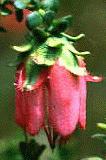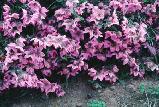|
[Front Page] [Features] [Departments] [SGAP Home Page] [Subscribe]

Australian Plants in California
Brett Hall
California is remarkable for many reasons, but especially for its astonishing diversity of habitats. Included within the state are the Sierra Nevada Mountains which reach elevations of 4,000 metres of more, and the Coast Ranges and Klamath Range which together extend from nearly one end of the State to the other (approximately 1200 km). There are also extensive deserts, deep river gorges and coastal sand dunes. There are mountains formed in recent geologic times and ancient mountains too with a variety of different substrates, each supporting their own special association of plants. There are extensive granitic ranges, and almost equally extensive areas of serpentine, among many others.
California is home to nearly 40 million people. Although all of us are not pioneers, there are pockets of California, notably areas of southern California, the San Francisco Bay area, and central coastal California with special emphasis around the Monterey Bay, where rich pioneering horticulture has occurred.
|
"California is a special place,
A slice of nature’s pie.
We’ve seen Big Sur, The Siskiyous,
like-wise the Granite Range . . ."
Sheridan Warrick, Natural History Field Quarter Song Book, 1977 |
|
Australian plants have long played a significant role in California gardens. Until very recently, however, most Australian plants in California were from seed with little selection for form, vigour and overall beauty. Among the important horticultural pioneers in central and northern California were, Marshall Olbrich, Lester Hawkins and Ray and Rose Williams. Long before it was fashionable to grow Australian natives these folks were conducting lavish experiments in horticulture and landscaping in the sixties and early seventies.
Marshall and Lester established Western Hills Rare Plant Nursery, north of San Francisco in the coastal hills near Bodega Bay where hundreds of magnificent Western Australian natives were thriving until the great freeze of December 1972. Temperatures there plummeted to minus 10 degrees Centigrade for several days in a row and sadly most of their collection was lost.
Meanwhile a hundred miles south in the little town of Watsonville (better known as the hub of the salad vegetable industry in USA) along the edge of Monterey Bay, Ray and Rose Williams were growing a wide range of Australian natives, many of which survived the 1972 freeze due to the milder temperatures. Ray and Rose brilliantly combined California natives with south-western African and Australian plants in many beautiful landscapes. One of their most celebrated landscapes at the time was the garden of Gavilan College near Gilroy, not far from their home and nursery in Watsonville.

Also, during the early and middle sixties the Arboretum at the University of California in Santa Cruz was getting underway. Dr. Ray Collett, the founding and current Director of the Arboretum worked closely with the founding Chancellor, Dr. Dean McHenry to establish the Arboretum site. Fortunately Ray Collett is a climatologist and geographer who also has an unusual grasp of ecology, horticulture and landscaping, along with a keen artistic sensibility.
Early on Ray Collett and Dean McHenry decided that Australian plants should become a specialty of the U.C.S.C. Arboretum. They realised that the great majority of Australian plants could be readily grown only in places that are climatically rather similar to Australia and that this, of course, ruled out much of the United States. But in the milder parts of California, particularly in Santa Cruz, they surmised that many Australian plants could be grown to perfection and this has proved to be the case.
|
"...in the milder parts of California, particularly in
Santa Cruz...many Australian plants could be grown to perfection...."
|
|
The Arboretum site was selected for its topographical variety and its great diversity of soil types and substrates. Many acres include soils from marine deposits consisting of deep sandy loams which are great for many Australian species. Much of the site slopes gently to the south, (which is of course the sunny aspect in the northern hemisphere), collecting heat while colder air spills off into gullies and hollows. Fortunately for testing purposes, a big hollow exists with the Arboretum in the form of an abandoned reservoir. Here cold air pools on the clearest and stillest of winter nights. Much valuable information has been learned from this hollow.
In the early and mid seventies, shortly after the great freeze of December 1972, California began to experience periods of drought. The winters of 1976 and 1977 still remain among the driest years on record for many areas of the state. Because of the drought, attention was turned to California native plants for use in landscaping, along with plants from other Mediterranean and arid climates, including Australia. It was during this time that the 'Australian Native Plant Movement' exploded on the horticultural horizon.
In the midst of all this Ray Collett and the Arboretum crew became friends with Rodger and Gwen Elliot, then of Montrose, Victoria, who by then were deeply involved in the Australian native plant movement. The Elliots began shipping selected rooted cuttings of Australian natives to Santa Cruz and the Arboretum began developing its Australian gardens.

The "Mountain bells" of Western Australia include Darwinia squarrosa, a small plant usually less than a metre in height. Select the thumbnail image or plant name for a higher resolution image (22k).
Photo: Santa Cruz Arboretum.

Thomasia grandiflora, is a Western Australian native species growing to about a half metre in height. Select the thumbnail image or plant name for a higher resolution image (34k).
Photo: Santa Cruz Arboretum.

Beaufortia is a small genus of Western Australian plants which are growing at Santa Cruz. The genus is related to Melaleuca. This is Beaufortia decussata. Select the thumbnail image or plant name for a higher resolution image (30k).
The list of Australian plants now growing in the U.C.S.C. Arboretum is too long to print here. Over 2000 species and cultivars are grown at U.C.S.C. Among the genera of Australian natives that are becoming well known and widely used in California are the following:
|
Acacia, Allocasuarina, Alyogyne, Anigozanthos, Araucaria, Baeckea, Banksia, Bauera, Beaufortia, Boronia, Brachychiton, Brachyscome, Callistemon, Callitris, Calocephalus, Calothamnus, Calytrix, Casuarina, Chamelaucium, Chorizema, Correa, Crowea, Cryptandra, Dacrydium, Dampiera, Darwinia, Dianella, Dryandra, Epacris, Eremophila, Eucalyptus, Eutaxia, Goodenia, Grevillea, Guichenotia, Hakea, Hardenbergia, Hemiandra, Hibbertia, Hypocalymma, Isopogon, Keraudrenia, Kunzea, Lambertia, Lechenaultia, Leptospermum, Leucophyta, Macrozamia, Melaleuca, Patersonia, Pimelea, Platytheca, Podocarpus, Restio, Rhagodia, Scaevola, Scholtzia, Sollya, Spyridium, Stackhousia, Stylidium, Tasmannia, Tetratheca, Thomasia, Thryptomene, Verticordia, Wahlenbergia, Westringia, Xanthorrhoea . . . plus many more.
|
Some Australian species have naturalised in different areas of the world and a few have become nuisance weeds. Included in this category are species of Acacia, Eucalyptus and Westringia. Any species that may have potential for naturalizing and becoming weeds are being watched carefully.
Why Grow Australian Plants in California?
Because California’s flora is so beautiful and diverse one could easily spend a life time just growing California plants.
But it is a part of horticultural human nature to look beyond our own shores for inspiration and new ideas. Australian plants exhibit such extraordinary combinations of textural beauty, fragrance, colour and floral design that they are hard to ignore once unveiled. Moreover, part of our purpose as an Arboretum is to illustrate concepts in evolution, plant systematics, biogeography and pollination ecology.
|
| "... it is a part of horticultural human nature to look beyond our own shores for inspiration and new ideas."
|
|
Australian plants illustrate extraordinarily unique and unusual evolutionary directions. They provide living art for people to enjoy and study. Ray Collett explained it very eloquently when he said, "These gardens serve more than practical, aesthetic and scientific purposes. They serve to remind us that on the shores of the Pacific are great nations. One should not be without reminders of the other".
This article is a reproduction of a paper presented by Brett at the SGAP 18th Biennial Seminar held at Ballarat, Victoria from 23 to 29 September 1995.
Brett Hall is Manager of the Arboretum of the University of California, Santa Cruz, and a graduate of the University. Over the past 20 years he has been involved along with the Director Dr Ray Collett in overseeing the establishment of the Arboretum which has excellent collections of plants from Australia, New Zealand, South Africa, New Caledonia and Western America. The Arboretum which has developed with a very limited budget and staff is regarded as one of the most exciting gardens in USA.
Brett is also actively involved in the conservation and cultivation of California’s indigenous flora.
 [Front Page] [Features] [Departments] [SGAP Home Page] [Subscribe]
[Front Page] [Features] [Departments] [SGAP Home Page] [Subscribe]
Australian Plants online - June 1997
The Society for Growing Australian Plants
|